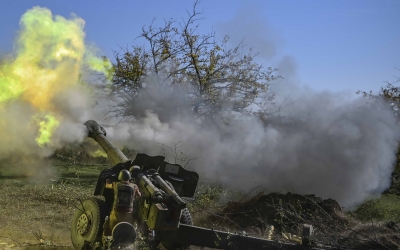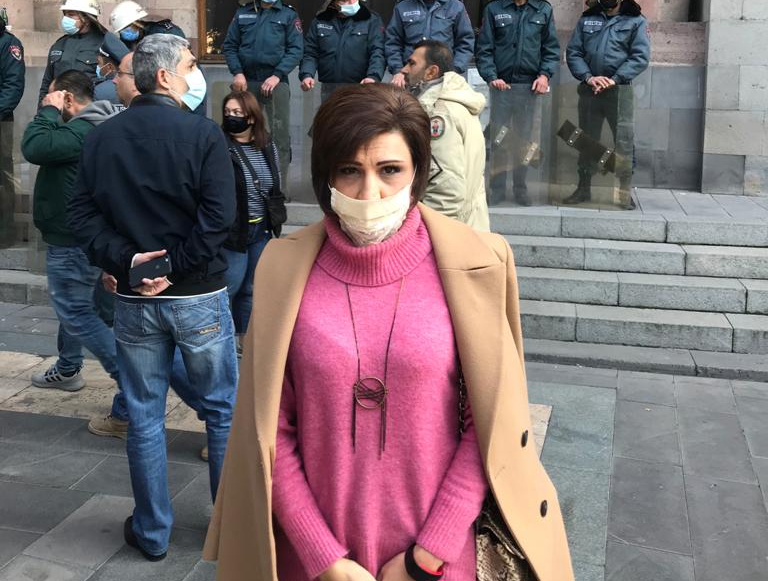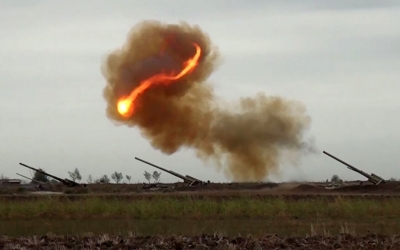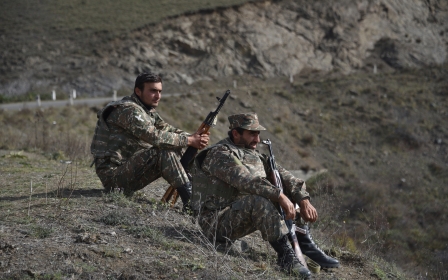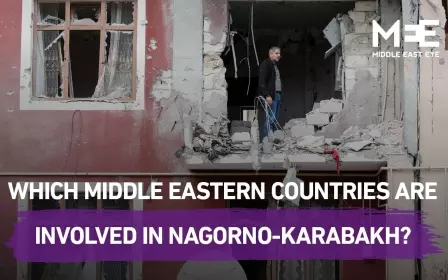Nagorno-Karabakh ceasefire greeted with anger and disbelief in Armenia
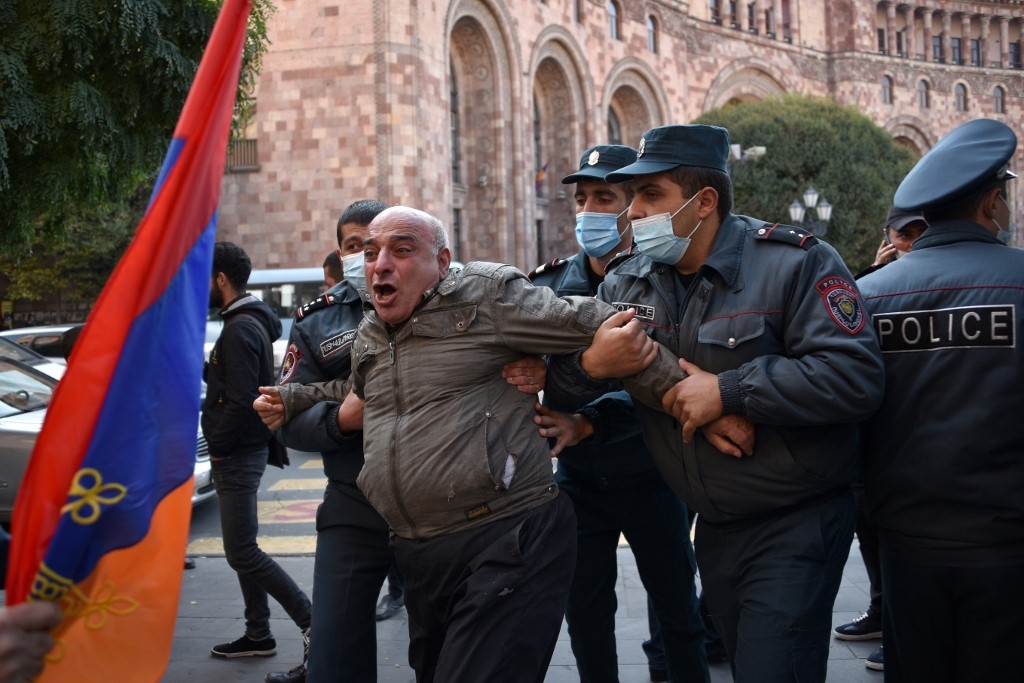
There was a profound sense of disbelief and national bereavement on the streets of the Armenian capital on Tuesday morning, as the country came to terms with the announcement of a ceasefire agreement to end its war with Azerbaijan over Nagorno-Karabakh.
Television pictures overnight showed an eruption of violence as angry protesters gathered in Yerevan's Republic Square, after Armenian Prime Minister Nikol Pashinyan confirmed details of the Russian- and Turkish-brokered deal in the early hours.
Many stormed inside the parliament building where the speaker, Ararat Mirzoyan, was assaulted and left unconscious before security forces were able to regain control.
By morning, much of that anger had been replaced by a numb sadness. Faces of passers-by and the largely empty streets were etched with grief.
New MEE newsletter: Jerusalem Dispatch
Sign up to get the latest insights and analysis on Israel-Palestine, alongside Turkey Unpacked and other MEE newsletters
One woman was weeping. She told MEE that she couldn’t sleep after the announcement. “I didn’t expect anyone in power would sell us out,” she said.
Her husband is still at the front in Stepanakert, the Armenian name for the capital of Nagorno-Karabakh, which Azerbaijanis call Khankendi.
She had just spoken to him by mobile phone. He confirmed to her that the fighting had stopped. But she had no idea whether she would ever be able to return to her home in the city and reopen the small shop she ran.
Frozen conflict
Nagorno-Karabakh is one of the most entrenched “frozen conflicts” originating from the breakup of the Soviet Union in late 1980s and early 1990s.
When Azerbaijan declared its independence from Moscow, it removed powers held by the enclave’s government.
The ethnic Armenian majority voted to secede from Baku. Tensions between the majority ethnic Armenians of Stepanakert and majority Azerbaijanis in the provinces around them grew and full-scale war erupted in 1992. That war continued for two years, with Armenian forces capturing much of the territory they have lost in fighting since September.
Many expressed shock on Tuesday at the suddenness of the ceasefire announcement. Until late last night, the message from Pashinyan and his government had been that victory was the only possible option.
This had been the unanimous message delivered by more than 10 members of parliament from all political factions that MEE had met in Yerevan over the past three days.
The same message was spelled out in official messages on every street corner. Advertising displays showed pictures of smiling young fighters at the front above the slogan “We will win”.
Many of those pictured soldiers are likely to be dead. Thousands of people are estimated to have died and more than 100,000 displaced since the latest round of fighting broke out on 27 September this year.
Soldiers back from the front
In Republic Square, soldiers recently returned from the front were milling around still in their combat gear. Tigran Sadoyan, a 45-year-old tractor driver in civilian life, told MEE he was among thousands of volunteers who had signed up to defend what they fervently believe to be Armenian land in Nagorno-Karabakh, which Armenians refer to as Artsakh.
Sadoyan said that he had two sons still at the frontline, then broke down in tears as he described how his nephew had been killed.
He described how Armenian forces were confronted with drones and artillery fire from Azerbaijani forces supported by Turkey. Like many we spoke to, he referred to the enemy simply as “Turks”.
Sadoyan accused Azerbaijani forces of shelling civilian towns, but said that Armenian forces had not been allowed to respond in kind.
Azerbaijan has announced the recapture of dozens of towns and settlements in recent days, including Shusha, Nagorno-Karabakh's second largest city, known as Shushi to Armenians.
Sadoyan said that Pashinyan was wrong to have agreed a ceasefire, adding “with Azerbaijan we will never be at peace”.
Outside the parliamentary building, a line of riot police separated a small agitated crowd from the glass doors and windows smashed by protesters overnight.
The group was calling for an end to the violence, for the government to go, and for the Armenian people to reject the ceasefire agreement.
Like many others, Ghor Shogik, a financial consultant, said that she had been unable to sleep since hearing the announcement last night and called for the ceasefire agreement to be rejected.
“I feel very distressed and unhappy. We need a new temporary government,” she said.
Gesturing to the broken windows, she added, “our goal is to stop violence”.
Asked by MEE whether she had any relations at the front, she simply replied: “Of course.”
As we spoke, there was a painful scene. A woman screamed “I have lost all my relatives. I have lost my house. What are you going to do about it?” She was gently led away by police.
Another woman addressed the group of protesters, telling them: “The prime minister is not a corrupt person. You are the ones who are corrupt.”
It was in Republic Square two years ago that thousands of people gathered in support of Pashinyan in mass protests that forced the resignation of then-prime minister Serzh Sargsyan.
The removal of Sargsyan and the arrival of Pashinyan was hailed as a great democratic moment in the modern history of Armenia, which became independent from the Soviet Union in 1991.
Now Pashinyan finds himself under threat. Sargsyan was closer to Russia than his successor. Some observers have been speculating for some time that Russian President Vladimir Putin’s failure to give his full backing to Armenia was influenced by events in 2018.
The future here in Yerevan is uncertain. It’s expected that Russia will seek to take advantage of the growing political crisis, which follows what is being seen by every Armenian we spoke to as a dark and perilous moment in the nation’s history.
Some do, however, take the pragmatic view that last night’s ceasefire was the only realistic course of action available to Pashinyan and his government in the face of a looming military defeat after the fall of Shusha, and one that has saved thousands of lives.
One hardened veteran of the 1990s conflict in Nagorno-Karabkh told MEE that Pashinyan had made the right decision.
“If we had carried on we would only have lost. Many more people would have been killed.”
The fighting may have ended, but this man, along with the thousands of others who have been displaced from their homes in the region, has no idea whether he will ever be able to return.
Peter Oborne and Jan-Peter Westad reported from Yerevan, Armenia.
Middle East Eye delivers independent and unrivalled coverage and analysis of the Middle East, North Africa and beyond. To learn more about republishing this content and the associated fees, please fill out this form. More about MEE can be found here.


